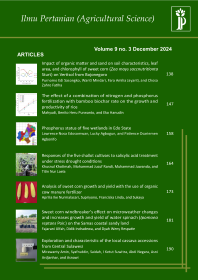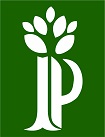Genetic parameters and yield potential of Indonesian soybean varieties (Glycine max L.) in wetland during dry season
Fadila Ridara(1), Riska Fitriani(2), Azka Algina(3), Debby Ustari(4), Agung Karuniawan(5*)
(1) Faculty of Agriculture, Universitas Padjadjaran, Bandung, Indonesia
(2) Faculty of Agriculture, Universitas Padjadjaran, Bandung, Indonesia
(3) Faculty of Agriculture, Universitas Padjadjaran, Bandung, Indonesia
(4) Faculty of Agriculture, Universitas Padjadjaran, Bandung, Indonesia Faculty of Agriculture, Universitas Islam Nusantara, Bandung, Indonesia
(5) Faculty of Agriculture, Universitas Padjadjaran, Bandung, Indonesia
(*) Corresponding Author
Abstract
Keywords
References
Adie, M. M., Baliadi, Y., Yusnawan, E., Wijanarko, A. and Krisnawati, A. (2022). Performance of Soybean Genotypes in the Acidic Dryland and Wetland. International Journal on Advanced Science, Engineering and Information Technology, 12(5), 1812–1817.
Ahakpaz, F., Abdi, H., Neyestani, E., Hesami, A., Mohammadi, B., Mahmoudi, K. N., Abedi-Asl, G., Noshabadi, M. R. J., Ahakpaz, F. and Alipour, H. (2021). Genotype-by-environment interaction analysis for grain yield of barley genotypes under dryland conditions and the role of monthly rainfall. Agricultural Water Management, 245(October 2020), 106665.
Aldri, V. A and Sitti, R.F. (2023). Analisis Pengaruh Harga Kedelai Lokal, Produksi Kedelai Lokal, Kurs, Dan Konsumsi Kedelai Dalam Negeri Terhadap Tingginya Impor Kedelai Di Indonesia Tahun 1997-2021. JEMSI (Jurnal Ekonomi, Manajemen, Dan Akuntansi), 9(4), 1354–1358.
Almeida, F. R., Brayner, A., Rodrigues, J. P. C. and Bessa Maia, J. E. (2017). Improving multidimensionalwireless sensor network lifetime using pearson correlation and fractal clustering. Sensors (Switzerland), 17(6), 1–24.
Ambrósio, M., Daher, R. F., Santos, R. M., Santana, J. G. S., Vidal, A. K. F., Nascimento, M. R., Leite, C. L., de Souza, A. G., Freitas, R. S., Stida, W. F., Farias, J. E. C., de Souza Filho, B. F., Melo, L. C. and dos Santos, P. R. (2024). Multi-trait index: selection and recommendation of superior black bean genotypes as new improved varieties. BMC Plant Biology, 24(1), 1–12.
Bates, D., Maechler, M., Bolker, B., Walker, S., Christensen, R. H. B., Singmann, H., Dai, B., Scheipl, F., Grothendieck, G., Green, P., Fox, J., Bauer, A., Krivitsky, P. N., Tanaka, E. and Jagan, M. (2024). Linear Mixed-Effects Models using “Eigen” and S4. In The R Project for Statistical Computing (1.1-35.5; pp. 50–51). CRAN.
Du, Y., Zhao, Q., Chen, L., Yao, X. and Xie, F. (2020). Effect of drought stress at reproductive stages on growth and nitrogen metabolism in soybean. Agronomy, 10(2).
Du, Y., Zhao, Q., Chen, L., Yao, X., Zhang, H., Wu, J. and Xie, F. (2020). Effect of drought stress during soybean r2–r6 growth stages on sucrose metabolism in leaf and seed. International Journal of Molecular Sciences, 21(2), 1–19.
Egli, D. B. (2017). Seed biology and yield of grain crops. In Seed biology and yield of grain crops.
Elmerich, C., Boulch, G., Faucon, M. P., Lakhal, L. and Lange, B. (2023). Identification of Eco-Climatic Factors Driving Yields and Genotype by Environment Interactions for Yield in Early Maturity Soybean Using Crop Simulation. Agronomy, 13(2).
Gerrano, A. S., Jansen van Rensburg, W. S., Mathew, I., Shayanowako, A. I. T., Bairu, M. W., Venter, S. L., Swart, W., Mofokeng, A., Mellem, J. and Labuschagne, M. (2020). Genotype and genotype × environment interaction effects on the grain yield performance of cowpea genotypes in dryland farming system in South Africa. Euphytica, 216(5), 1–11.
Ghorbani, R., Alemzadeh, A. and Razi, H. (2019). Microarray analysis of transcriptional responses to salt and drought stress in Arabidopsis thaliana. Heliyon, 5(11), e02614. https://doi.org/10.1016/j.heliyon.2019.e02614
Grenfell, S., Grenfell, M., Tooth, S., Mehl, A., O’Gorman, E., Ralph, T. and Ellery, W. (2022). Wetlands in drylands: diverse perspectives for dynamic landscapes. Wetlands Ecology and Management, 30(4), 607–622. https://doi.org/10.1007/s11273-022-09887-z
Harsono, A., Harnowo, D., Ginting, E. and Elisabeth, A. A. D. (2022). Soybean in Indonesia: Current Status, Challenges and Opportunities to Achieve Self-Sufficiency. Legumes Research - Volume 1. https://doi.org/10.5772/intechopen.101264
Islam, M. R., Sarker, B. C., Alam, M. A., Javed, T., Alam, M. J., Zaman, M. S. U., Azam, M. G., Shabbir, R., Raza, A., Habib‐ur‐rahman, M., Dessoky, E. S. and Islam, M. S. (2021). Yield stability and genotype environment interaction of water deficit stress tolerant mung bean (Vigna radiata l. wilczak) genotypes of Bangladesh. Agronomy, 11(11). https://doi.org/10.3390/agronomy11112136
Kang, Y., Li, M., Sinharoy, S. and Verdier, J. (2016). A snapshot of functional genetic studies in Medicago truncatula. Frontiers in Plant Science, 7(AUG2016). https://doi.org/10.3389/fpls.2016.01175
Kearsey, J. M. and Pooni, S. H. (1996). The Genetical Analysis of Quantitative Traits. In Sringger Science Business Media, B.V. (Vol. 33, Issue 11). https://doi.org/10.1136/jmg.33.11.976
Khandelwal, V., Patel, R., Choudhary, K. B., Pawar, S. B., Patel, M. S., Iyanar, K., Mungra, K. D., Kumar, S. and Satyavathi, C. T. (2024). Stability Analysis and Identification of Superior Hybrids in Pearl Millet [Pennisetum glaucum (L.) R. Br.] Using the Multi Trait Stability Index. Plants, 13(8), 1–22.
Kuhn, M., Jackson, S. and Cimentada, J. (2022). Correlations in R Package ‘ corrr ’ (0.4.4). CRAN.
Mahaman, M. I. Z., Oselebe, H. O., Baina, D. jimo, Nwankwo Innocent, I. M., Houdegbe, A. C., Oumarou, S., Chukwu, S. C. and Moussa, B. (2023). Selection of new sweetpotato hybrids for West Africa using accelerated breeding scheme and genotype × environment interaction under drought stress. Scientific Reports, 13(1), 1–13.
Majidian, P., Masoudi, B., Hezarjaribi, E., Razmi, N., Peyghamzadeh, K. and Gholizadeh, A. (2024). Deciphering genotype-by-environment interaction in new soybean lines based on multiple traits using different adaptability and stability methods. Food Science and Nutrition, 12(5), 3295–3308.
Markulj Kulundžić, A., Josipović, A., Matoša Kočar, M., Viljevac Vuletić, M., Antunović Dunić, J., Varga, I., Cesar, V., Sudarić, A. and Lepeduš, H. (2022). Physiological insights on soybean response to drought. Agricultural Water Management, 268(March).
Mburu, S. W., Koskey, G., Njeru, E. M., Ombori, O., Maingi, J. and Kimiti, J. M. (2022). Genetic and phenotypic diversity of microsymbionts nodulating promiscuous soybeans from different agro-climatic conditions. Journal of Genetic Engineering and Biotechnology, 20(1), 109.
Mekonnen, T. W., Mekbib, F., Amsalu, B., Gedil, M., & Labuschagne, M. (2022). Genotype by environment interaction and grain yield stability of drought tolerant cowpea landraces in Ethiopia. Euphytica, 218(5), 1–13.
Montanha, G. S., Perez, L. C., Brandão, J. R., de Camargo, R. F., Tavares, T. R., de Almeida, E. and de Carvalho, H. W. P. (2022). May mineral composition trigger or limit the protein content in soybean (Glycine max (L.) Merrill) seeds? Insights from a survey on 95 varieties cultivated in Brazil. BioRxiv.
Nakagawa, A. C. S., Ario, N., Tomita, Y., Tanaka, S., Murayama, N., Mizuta, C., Iwaya-Inoue, M. and Ishibashi, Y. (2020). High temperature during soybean seed development differentially alters lipid and protein metabolism. Plant Production Science, 23(4), 504–512.
Onder, S., Erbas, S., Onder, D., Tonguc, M. and Mutlucan, M. (2022). seed filling. IntechOpen, 11(tourism), 13.
Palaniyappan, S., Ganesan, K. N., Manivannan, N., Ravichandran, V. and Senthil, N. (2023). Multi trait genotype- ideotype distance index - A tool for identification of elite parental inbreds for developing heterotic hybrids of fodder maize (Zea mays L.). Electronic Journal of Plant Breeding, 14(3), 841–849.
Rahimi Moghaddam, S., Amiri, S. and Eyni-Nargeseh, H. (2023). Assessing chickpea attainable yield and closing the yield gaps caused by agronomic and genetic factors. Field Crops Research, 303(September), 109137.
Rani, R., Arif, M., Rahman, S. U., Hammad, M., Mukhtar, Z., Rizwan, M., Shimelis, H. and Raza, G. (2023). Field Screening of Diverse Soybean Germplasm to Characterize Their Adaptability under Long-Day Condition. Agronomy, 13(9), 1–17.
Resende, M. D. V. (2002). Genética biométrica e estatística no melhoramentode plantas perenes. In Pesquisa Agropecuaria Brasileira (Issue 10).
Rychel-Bielska, S., Książkiewicz, M., Kurasiak-Popowska, D., Tomkowiak, A., Bielski, W., Weigt, D., Niemann, J., Surma, A., Kozak, B. and Nawracała, J. (2024). Molecular selection of soybean towards adaptation to Central European agroclimatic conditions. Journal of Applied Genetics.
Saryoko, A., Homma, K., Lubis, I. and Shiraiwa, T. (2017). Plant development and yield components under a tropical environment in soybean cultivars with temperate and tropical origins. Plant Production Science, 20(4), 375–383.
Sehgal, A., Sita, K., Siddique, K. H. M., Kumar, R., Bhogireddy, S., Varshney, R. K., HanumanthaRao, B., Nair, R. M., Prasad, P. V. V. and Nayyar, H. (2018). Drought or/and heat-stress effects on seed filling in food crops: Impacts on functional biochemistry, seed yields, and nutritional quality. Frontiers in Plant Science, 871(November), 1–19.
Singamsetti, A., Zaidi, P. H., Seetharam, K., Vinayan, M. T., Olivoto, T., Mahato, A., Madankar, K., Kumar, M. and Shikha, K. (2023). Genetic gains in tropical maize hybrids across moisture regimes with multi-trait-based index selection. Frontiers in Plant Science, 14(March), 1–16.
Tanwar, B. and Goyal, A. (2020). Oilseeds: Health Attributes and Food Applications. In Oilseeds: Health Attributes and Food Applications.
Terryana, R. T., Safina, N. D., Suryani, S., Nugroho, K. and Lestari, P. (2020). Analisis Keragaman Genetik Aksesi Kedelai Introduksi Dari Wilayah Subtropis Berbasis Morfologi Dan Molekuler. Berita Biologi, 19(3B).
Triyanti, D. R. (2020). Outlook Kedelai 2020. Pusat Data Dan Sistem Informasi Pertanian Sekretariat Jenderal Kementerian Pertanian, 1–84.
United States Department of Agriculture. (2023). Production - Soybeans [online]. Available at: https://www.fas.usda.gov/data/production/commodity/2222000 [Accessed 25 February 2025].
Valliyodan, B., Brown, A. V., Wang, J., Patil, G., Liu, Y., Otyama, P. I., Nelson, R. T., Vuong, T., Song, Q., Musket, T. A., Wagner, R., Marri, P., Reddy, S., Sessions, A., Wu, X., Grant, D., Bayer, P. E., Roorkiwal, M., Varshney, R. K., and Nguyen, H. T. (2021). Genetic variation among 481 diverse soybean accessions, inferred from genomic re-sequencing. Scientific Data, 8(1), 1–9.
Vogel, J. T., Liu, W., Olhoft, P., Crafts-Brandner, S. J., Pennycooke, J. C. and Christiansen, N. (2021). Soybean Yield Formation Physiology – A Foundation for Precision Breeding Based Improvement. Frontiers in Plant Science, 12(November), 1–15.Article Metrics
Refbacks
- There are currently no refbacks.
Ilmu Pertanian (Agricultural Science) ISSN 0126-4214 (print), ISSN 2527-7162 (online) is published by Faculty of Agriculture Universitas Gadjah Mada collaboration with Perhimpunan Sarjana Pertanian Indonesia (PISPI) and licensed under a Creative Commons Attribution-ShareAlike 4.0 International License.














